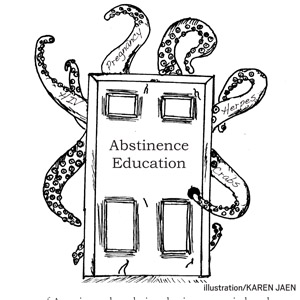 In 2003, Florida began to pursue an abstinence-only education plan. By 2007, Florida was second only to Texas in the amount it spent to spread its message of abstinence. Since then, the Obama administration has cut all federal funding for abstinence-only programs, making it more difficult for districts to retain their programs. This is a good move and is in the best interest of students.
In 2003, Florida began to pursue an abstinence-only education plan. By 2007, Florida was second only to Texas in the amount it spent to spread its message of abstinence. Since then, the Obama administration has cut all federal funding for abstinence-only programs, making it more difficult for districts to retain their programs. This is a good move and is in the best interest of students.
On campus, the required HOPE course includes STD prevention and control, teen pregnancy prevention and risk factor assessments. However, students across country are still being taught abstinence only.
A sex education course should contain an emphasis on abstinence as it is the only sure way to prevent Sexually Transmitted Diseases and pregnancy. However, it should also include accurate and current information about methods to prevent STDs and pregnancy. Sex education should include and emphasize the risks of having sex.
According to the Center for Disease Control and Prevention, 66 percent of teenagers have had sex by 12th grade. A significant number are being forced to make their own conclusions about contraceptives. This trend has produced myths like smoking marijuana will prevent pregnancy and drinking a shot of Mountain Dew will reduce sperm count.
Sexually active teens represent nearly half of students today. Schools need to serve the public, not preach to their students. While abstinence is certainly the safest choice, it is still the student’s choice whether he or she will be sexually active.
By not educating students, schools are risking that those who do not remain abstinent will become sexually active without proper education. It cannot be ignored that one in two sexually active youth will contract an STD by the time they are 25. It cannot be ignored that 40 percent of older adolescents surveyed by the Kaiser Family Foundation believe that a contraceptive pill can prevent one from getting STDs and HIV.
It is understandable that parents worry about the sex information their child receives at school. They may think it is not the education system’s place to teach such a sensitive subject, that it should be taught at home. This is hardly an argument when, according to the CDC and Prevention, 70 percent of mothers believed their sons are virgins when only about 44 percent actually are. Lessons at school are the only way to ensure that all who are sexually active receive proper sex education. Those who reject learning about prevention in school may regret it later when a friend comes to them for advice or if they change their mind about sex. Even those opposed to teaching about STDs and pregnancy prevention for religious reasons should be knowledgeable on the subject.
Many religions, including Christianity, forbid premarital sex. Religious groups worry that schools encourage students to have sex by teaching about contraceptives. This is a reasonable concern. However, a study conducted by the National Campaign to Prevent Pregnancy found that comprehensive sex education did not increase sexual activity, but reduced it and increased condom use among those already having sex. Though 75 percent of Americans identify themselves as Christians, 75 percent of Americans also admit to having premarital sex by age 20 according to a study in Public Health Reports.
Those who are choosing to have sex are suffering from not being educated, and it is unfair for public schools to punish them for their choices, especially when the punishment could be an STD or unexpected pregnancy. It is not the state’s job to determine whether a teen should be sexually active or not.
Abstinence should still be encouraged as the safest way to avoid pregnancy and STD; however, public schools need to prepare their students and ensure that their decision to become sexually active is an educated one.